Kyabje Togden Amtrin
The Brief Life Story Of Togden Amtrin, Thrinley Lodro
by Jamyang Tenphel
What follows is the brief life story of Kyabje Togden Amtrin, my Guru. Although it is difficult to know the exact date, Togden Amtrin was born in 1922 in Lhatok, Kham. He became a monk at the age of 14, taking ordination in the Drukpa Kagyu School, and was given the name Thrinley Lodro by the Seventh Khamtrul Rinpoche of Khampagar Gompa, Kham. Under the guidance of his Heart Lama, Tulku Lhagen Sonam Tenzin (So-Ten) Rinpoche, Togden Amtrin began formal retreat in the Khampagar retreat centre at the age of twenty, though he had done retreats from a younger age. He went off to meditate alone in caves at the age of twenty-four. Before he went into retreat he cared for an older monk until that monk’s passing. Amtrin-la was given the Yidam practice of Yamantaka Tro-chu to practice in retreat, which is a Yidam unique to the Drukpa Kagyu School, and a practice that is not commonly given. This practice is a Nyingma terma revealed by Soten (Lhagen) Rinpoche.
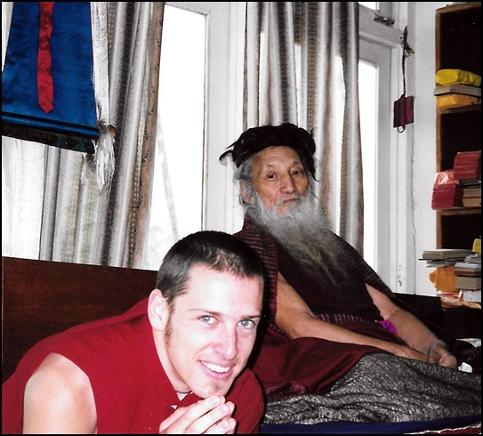
Jamyang Tenphel with his Guru, Kyabje Togden Amtrin (2004)
Kyabje Togden Amtrin
Amtrin-la’s other Root Guru, the Eighth Khamtrul Rinpoche, also practiced this form of Yamantaka as his main practice, and both were given this by So-ten Rinpoche. Aside from his Yamantaka practice, Togden Amtrin was a Master of all of the heart practices of the Khampagar Drukpa including Trul-Khor (aka Tsa-Lung, physical yoga practice), the Six Yogas of Naropa, and the teachings on Mahamudra. Amtrin-la also accomplished the heart practices of the Longchen Nyinthig tradition of the Nyingma lineage culminating in Dzogchen, and had tremendous devotion and reverence for Longchenpa. Amtrin-la received the Longchen Nyinthig teachings from Kyabje Dilgo Khyentse Rinpoche, among others. Togden Amtrin was also a lineage holder of the Longsal Nyingpo terma cycle lineage. He received introduction into this practice lineage from his Guru, So-Ten Rinpoche.
Kyabje Togden Amtrin's main Dzogchen master was Rigdzin Changchub Dorje (1863 - 1963) a heart student of Togden Shakya Shri and contemporary of Dudjom Lingpa. Rigdzin Changchub Dorje was from Gonjo, an area in far eastern Tibet not far from Khampagar monastery, the seat of the Khamtrul Rinpoches of the Drukpa Kagyu lineage. Drugu Choegyal Rinpoche notes that Togden Amtrin had a strong connection with Rigdzin Changchub Dorje and often travelled to Gonjo to visit him and receive Dzogchen teachings (See HERE). Apart from Togden Amtrin, Rigdzin Changchub Dorje's students included Chogyal Namkhai Norbu Rinpoche and Lama Wangdor Rinpoche.
Togden Amtrin described himself as a Ka-Nying practitioner, practicing both Kagyu and Nyingma Lineage teachings. Tsoknyi Rinpoche described Togden Amtrin as being in the spiritual tradition of the Drukpa, but his practice being Nyingma, specifically Dzogchen.
At the age of thirty-seven, Amtrin-la left Tibet because of the Chinese invasion and occupation and escaped across the border to India, and settled first in Dalhousie, in Himachal Pradesh (North-West India). Amtrin-la remained in Dalhousie, with some of the other Khampagar Togdens and monks, until the Eighth Khamtrul Rinpoche found land on which to re-found Khampagar in exile. Khamtrul Rinpoche chose a site in the Kangra Valley in Himachal Pradesh, and named his new Khampagar settlement Tashijong, meaning Auspicious Valley.
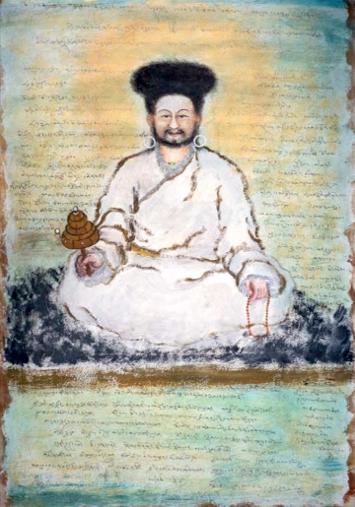
Rigdzin Changchub Dorje by Drugu Chogyal Rinpoche
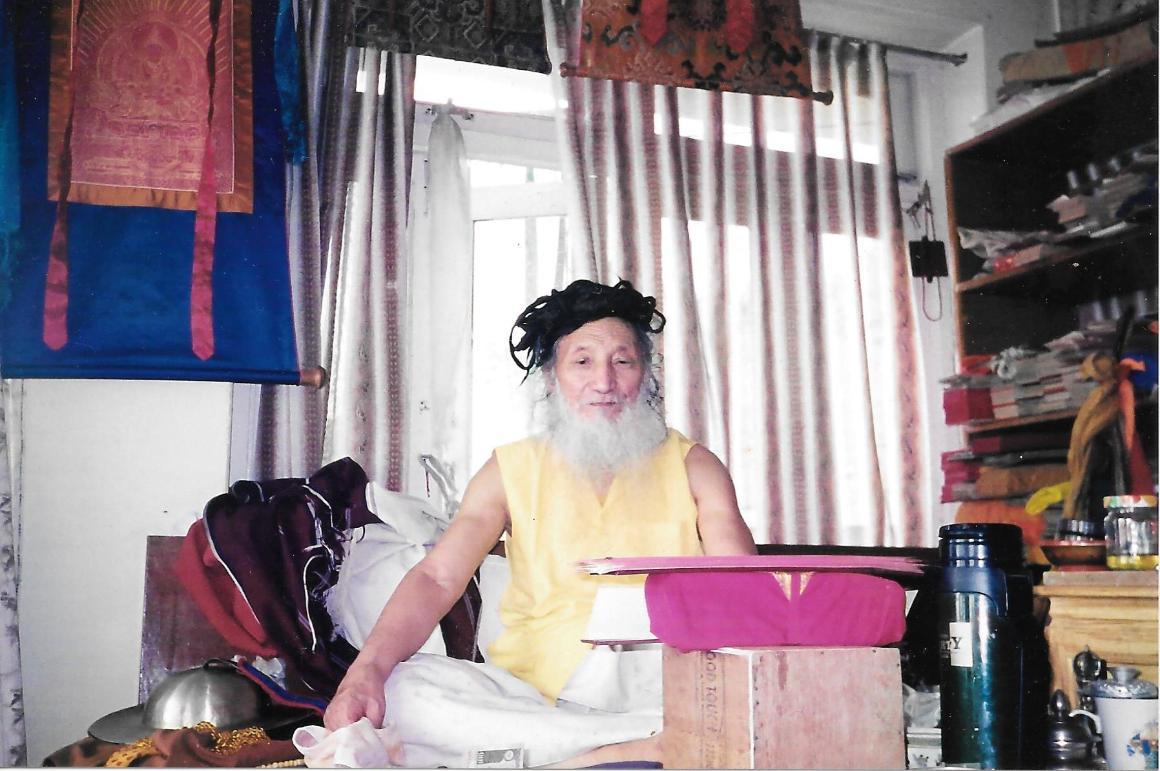
Kyabje Togden Amtrin (photo taken by Jamyang Tenphel)
Once the community moved to Tashijong, every Rinpoche, Togden, Monk, Nun and Lay person helped to build this new community with their bare hands. They carried rocks and water from the nearby river, and constructed the new gompa from scratch. After this time Amtrin-la continued to spend periods of retreat in the caves around Tashijong, living the life of an itinerant Yogi, as well as living in the monastery retreat centre. Whilst living in and around the retreat centre, he trained young monks and future Togdens, and also gave empowerments and teachings to the community. Once Jetsunma Tenzin Palmo’s nunnery began to function, Togden Amtrin taught and advised her nuns on practice and retreat also.
As Togden Amtrin got older, he settled in a small hut in the forest just outside the retreat centre in Tashijong, and in his late seventies he moved into Popa Rinpoche’s house. Togden Amtrin rarely left his room in his later years, even refusing a request by the Queen of Bhutan to teach and give empowerments. Amtrin-la did, however, on the request of his Korean students, visit the holy cave of Maratika in Nepal in his later years, to do Long-life practices.
Amtrin-la had a natural love of teaching. Without breaking his retreat, he continued to receive anyone who wanted his guidance or advice year round. Even when my great Lama was very ill himself, he continued to see visitors every day, always displaying perfect Skilful Means, Equanimity and the power of his Wisdom.
Throughout his life Amtrin-la was a constant example of a true Dharma practitioner and great Yogi, foregoing comfort and convenience in order to practice continuously. His incredible attitude of doing whatever had to be done to continue his practice was comparable to that of Milarepa, whom Amtrin-la regularly quoted and told stories about. Secretly, I believe that Togden Amtrin was really the same as the great saint Milarepa. There is a story from Jetsunma Tenzin Palmo that illustrates Togden Amtrin’s amazing attitude: “Back in Tibet one old Togden, Amtrin, had meditated on the edge of a precipice to stop himself from falling asleep. He had lived for years on just water and tsampa, and when that ran out had salvaged what was left over from a leopard’s kill. One day the leopard caught him picking up the bits of a deer and had chased him. Amtrin-la, realising how attached he still was to food, had dropped the meat and returned to his cave to continue meditating on an empty stomach” (from Cave in the Snow, 1999).
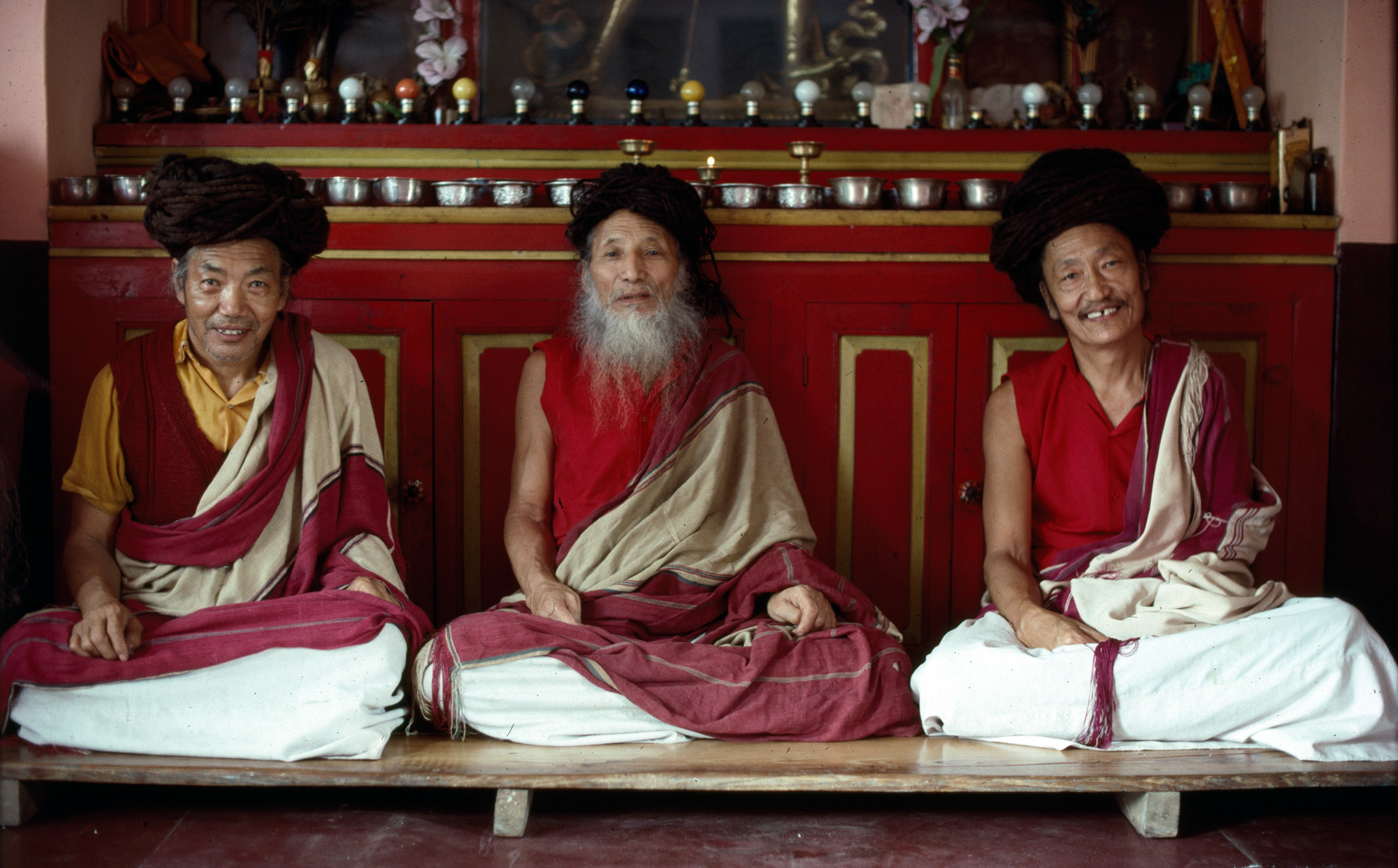
Tsoknyi Rinpoche tells a story about Togden Amtrin that illustrates his tenacity, perseverance and commitment to achieve realisation no matter what the cost:
"When he [Togden Amtrin] lived in Tibet, he practiced meditation a lot and became very peaceful. He stayed in solitary retreat for six years, and the retreat situation was very comfortable, very nice. … After six years, Amtrin felt that his practice was going very well indeed. But then he thought, "Well, who knows, maybe this practice has just turned me into a tranquil vegetable." So he asked his master, Khamtrul Rinpoche, "Wouldn't it perhaps be better if I went to a scary place, a rough, rugged, unpleasant place?" Khamtrul Rinpoche said, "Yes, definitely, you should go to such a place," and he gave directions to a particular location. Arriving there, Amtrin found a huge cave where the sun never shone, with water trickling down the entrance. In the evening, a large flock of pigeons flew around inside, making a lot of noise while shitting down on him. The first day he didn't know what was going on. He put out various containers to collect the water trickling down, but when he drank from it, he said, "What is this? It has a strange taste." Later he realized it was urine from the pigeons.
The cave was cold and damp, noisy, and scary at night. As he practiced there he found that his former peace of mind was tracelessly gone. He thought, "My practice has gone to pieces. Now what should I do?" And he felt that whatever he had done in the past didn't amount to much, so now he really had to practice. It was very difficult in the beginning, with the restless pigeons flying around in the dark. It was like being in the bardo, with all the turmoil and noise. Amtrin tried to cultivate this inner strength of rigpa by not surrendering himself to the distraction, by not getting carried away with the noise. He trained like that over and over again. He stayed in that place for maybe another six years. And now, whatever happens, whether it is pleasant or unpleasant, really doesn't affect him. He doesn't care anymore. But that doesn't mean that he ignores everything. I believe that when Amtrin dies, he probably won't have that much trouble in the bardo. For him, all emotions are, as they say, subsumed within the expanse of rigpa. In other words, he's free." (Fearless Simplicity, 2003, pp. 186-187).
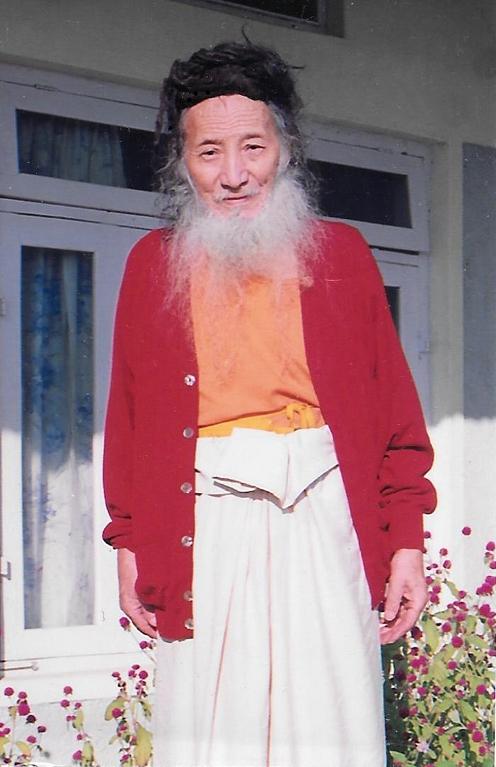
Togden Amtrin spent ten years in retreat in this “pigeon cave” and others in the mountains near Khampagar monastery in Eastern Tibet. Once in exile, Amtrin-la acted as the Eighth Khamtrul Rinpoche’s attendant and with him travelled widely to Bhutan, Sikkim and Nepal, among other places.
Whenever one of Amtrin-la’s students asked advice on what to do with their lives, Amtrin-la always said to just practice. “Should I learn Tibetan Amtrin-la?” “Well you could, but it would be better to just practice”. Togden Amtrin also often gave quite loose advice, constantly trying to guide his students towards developing self-confidence and spiritual autonomy. He constantly displayed his profound Equanimity, and advised people from all races, ages and genders. He was completely beyond caring about form and categories, and gave you direct and simple advice. Amtrin-la enjoyed teaching greatly, and often taught from Milarepa's biography, as well as from Words of my Perfect Teacher by Patrul Rinpoche.
Togden Amtrin passed away on Friday the 1st of July 2005. A comet was observed in the vicinity of the earth at this time. Where I was living at the time, in Comboyne, New South Wales, a perfectly blue sky was on show, and a “shower of Blessings” rain fell lightly over the next few days. Tsoknyi Rinpoche wrote this about Togden Amtrin-la's Parinirvana:
"At the age of 84 Togden Amtin passed away peacefully in Tashi Jong, India on Friday July 1st, the 25th day of the fifth Tibetan month, Dakini day. The atmosphere was very calm and the process of dying happened very smoothly. Earlier on Togden Amtin experienced some pain but this passed. In his final moments Togden Amtin was very much at peace, just like a flame slowly fading. From time to time he opened his eyes and his gaze was very direct and clear although he no longer had enough power in his body to speak or move. Just before Togden Amtin’s passing and at the moment of his death, Dorzong Rinpoche whispered instructions in his ear: a reminder of the natural luminosity of mind. At 7:15 pm Togden Amtrin died. He remained in tugdam for one and a half days; very subtle vital signs were evident. No-one went inside his room and the outside was kept very quiet. That night under the cover of darkness the young togdens came and sat outside Amtrin’s hut mingling their minds with their teacher’s as they said their silent goodbye. When Togden Amtin’s tugdam was finished, all the Rinpoches and monks at Tashi Jong came to pray and offer khatas. The atmosphere was very calm."
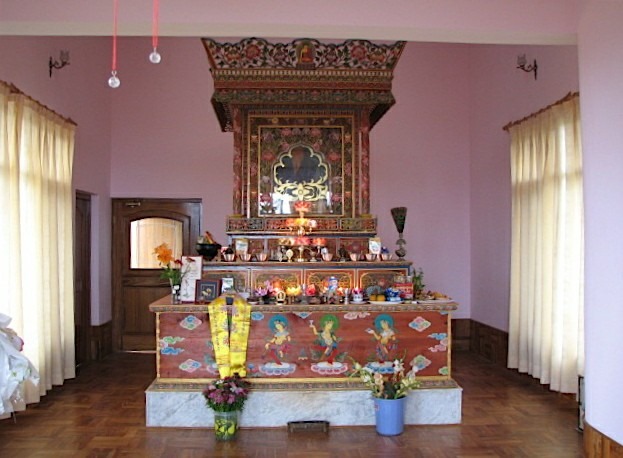
Togden Amtrin's Kudung
This brief account of the life and times of my Glorious Lama, Togden Amtrin was begun on Saturday the 14th of January 2006. In the Tibetan Calendar Year of 2132, the Wood Bird Year, on Amitabha Day, with a Full Moon shining. With devotion in my heart I have collected a few morsels of information about my Tsa-wai Lama, with the sincere wish that it may act to benefit anyone who may read this in the future.
I offer myself at the feet of my Incredible Lama. It is extremely rare to find a being such as he in these dark times; and so with faith, I offer him my Body, Speech, and Mind; as well as everything I have ever had, and ever will have, in order for him to transform them into the Perfected state. With deep yearning I implore my precious Lama to rest forever at the the center of my heart.
- Jamyang Tenphel
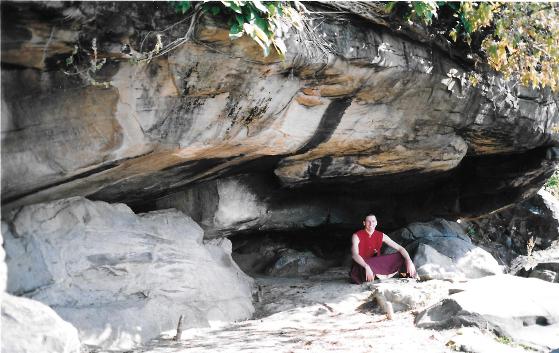
Jamyang Tenphel in one of Togden Amtrin's retreat caves, near Tashi Jong
© Copyright Pristine Awareness: Foundation for Buddhist Practice